Page 403 of 634
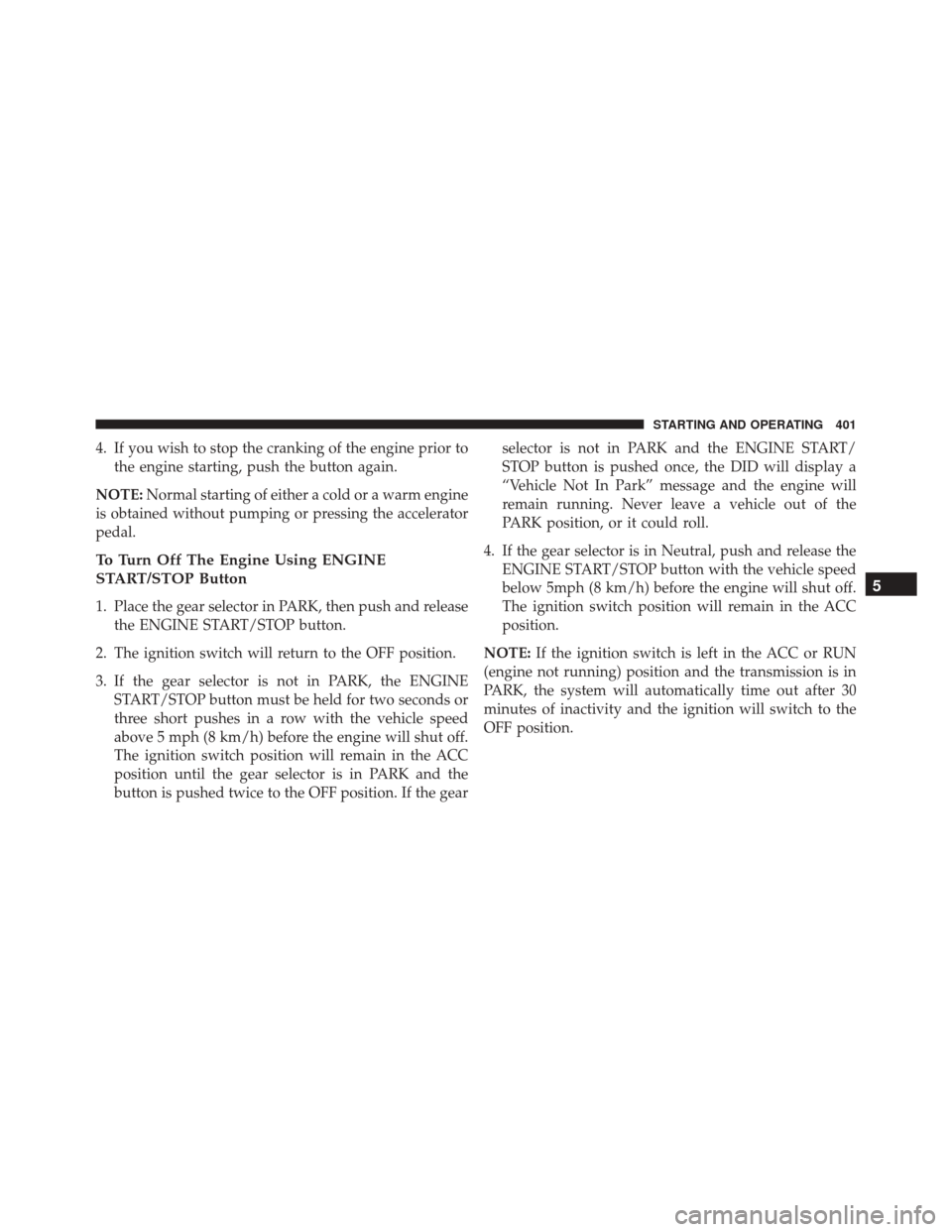
4. If you wish to stop the cranking of the engine prior tothe engine starting, push the button again.
NOTE: Normal starting of either a cold or a warm engine
is obtained without pumping or pressing the accelerator
pedal.
To Turn Off The Engine Using ENGINE
START/STOP Button
1. Place the gear selector in PARK, then push and release the ENGINE START/STOP button.
2. The ignition switch will return to the OFF position.
3. If the gear selector is not in PARK, the ENGINE START/STOP button must be held for two seconds or
three short pushes in a row with the vehicle speed
above 5 mph (8 km/h) before the engine will shut off.
The ignition switch position will remain in the ACC
position until the gear selector is in PARK and the
button is pushed twice to the OFF position. If the gear selector is not in PARK and the ENGINE START/
STOP button is pushed once, the DID will display a
“Vehicle Not In Park” message and the engine will
remain running. Never leave a vehicle out of the
PARK position, or it could roll.
4. If the gear selector is in Neutral, push and release the ENGINE START/STOP button with the vehicle speed
below 5mph (8 km/h) before the engine will shut off.
The ignition switch position will remain in the ACC
position.
NOTE: If the ignition switch is left in the ACC or RUN
(engine not running) position and the transmission is in
PARK, the system will automatically time out after 30
minutes of inactivity and the ignition will switch to the
OFF position.
5
STARTING AND OPERATING 401
Page 408 of 634
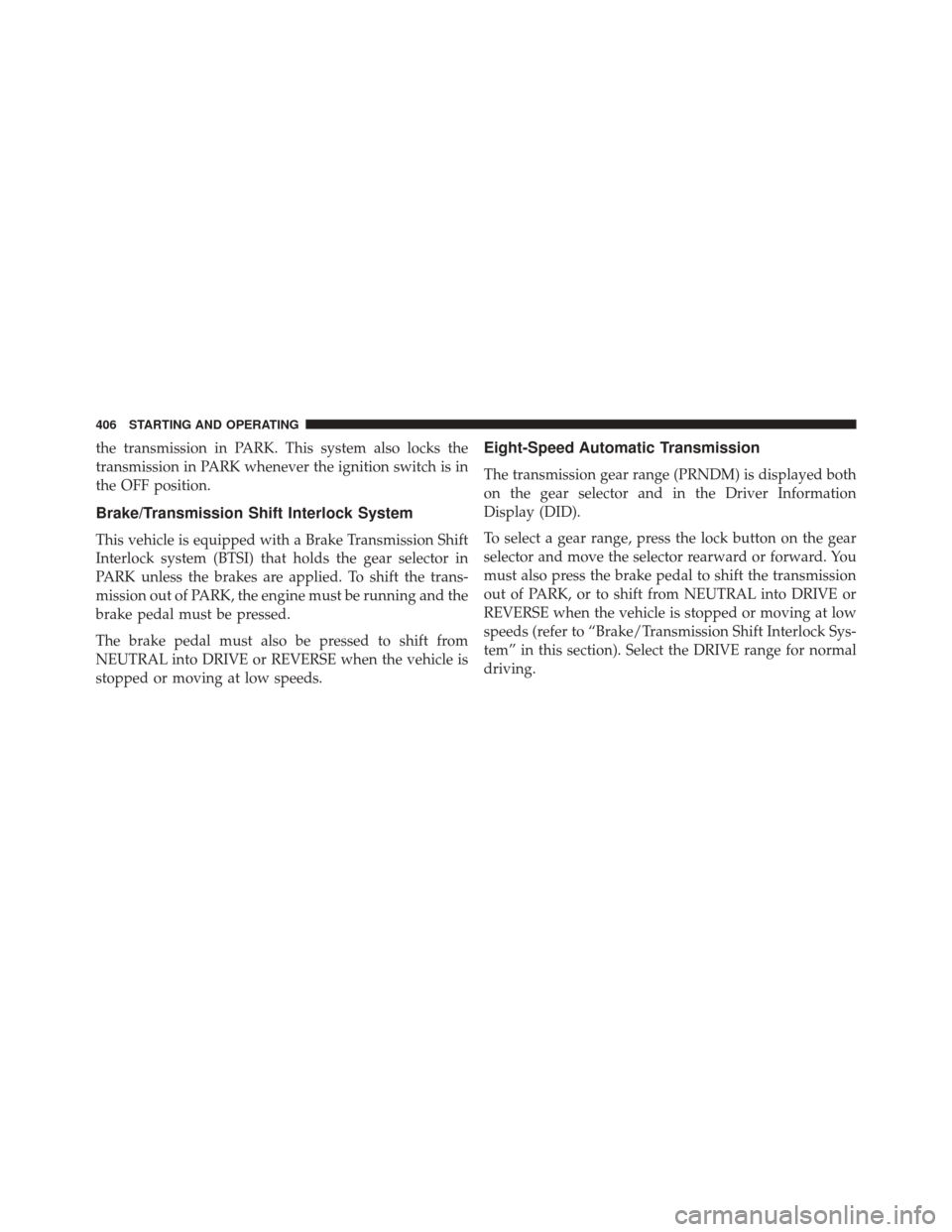
the transmission in PARK. This system also locks the
transmission in PARK whenever the ignition switch is in
the OFF position.
Brake/Transmission Shift Interlock System
This vehicle is equipped with a Brake Transmission Shift
Interlock system (BTSI) that holds the gear selector in
PARK unless the brakes are applied. To shift the trans-
mission out of PARK, the engine must be running and the
brake pedal must be pressed.
The brake pedal must also be pressed to shift from
NEUTRAL into DRIVE or REVERSE when the vehicle is
stopped or moving at low speeds.
Eight-Speed Automatic Transmission
The transmission gear range (PRNDM) is displayed both
on the gear selector and in the Driver Information
Display (DID).
To select a gear range, press the lock button on the gear
selector and move the selector rearward or forward. You
must also press the brake pedal to shift the transmission
out of PARK, or to shift from NEUTRAL into DRIVE or
REVERSE when the vehicle is stopped or moving at low
speeds (refer to “Brake/Transmission Shift Interlock Sys-
tem” in this section). Select the DRIVE range for normal
driving.
406 STARTING AND OPERATING
Page 409 of 634
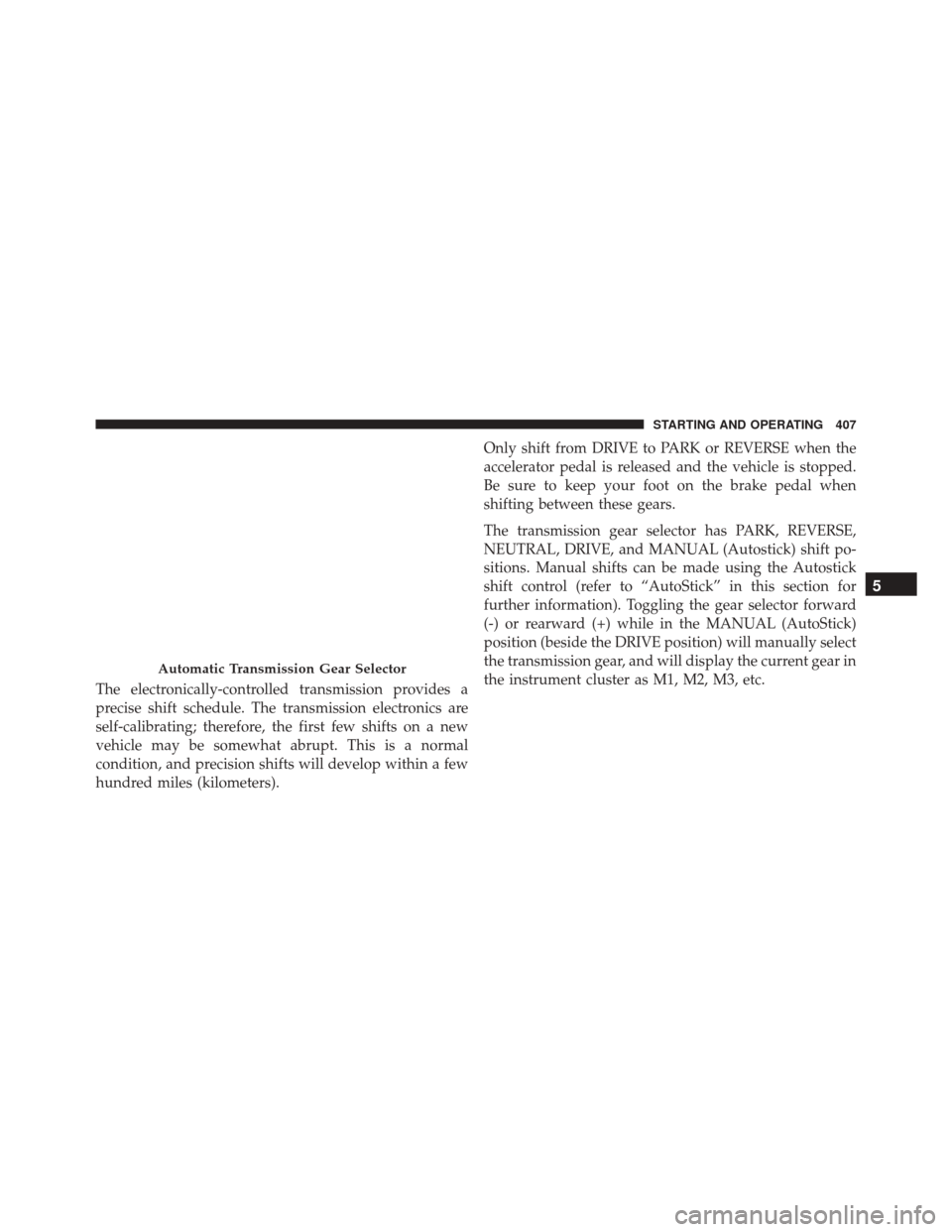
The electronically-controlled transmission provides a
precise shift schedule. The transmission electronics are
self-calibrating; therefore, the first few shifts on a new
vehicle may be somewhat abrupt. This is a normal
condition, and precision shifts will develop within a few
hundred miles (kilometers).Only shift from DRIVE to PARK or REVERSE when the
accelerator pedal is released and the vehicle is stopped.
Be sure to keep your foot on the brake pedal when
shifting between these gears.
The transmission gear selector has PARK, REVERSE,
NEUTRAL, DRIVE, and MANUAL (Autostick) shift po-
sitions. Manual shifts can be made using the Autostick
shift control (refer to “AutoStick” in this section for
further information). Toggling the gear selector forward
(-) or rearward (+) while in the MANUAL (AutoStick)
position (beside the DRIVE position) will manually select
the transmission gear, and will display the current gear in
the instrument cluster as M1, M2, M3, etc.
Automatic Transmission Gear Selector
5
STARTING AND OPERATING 407
Page 410 of 634
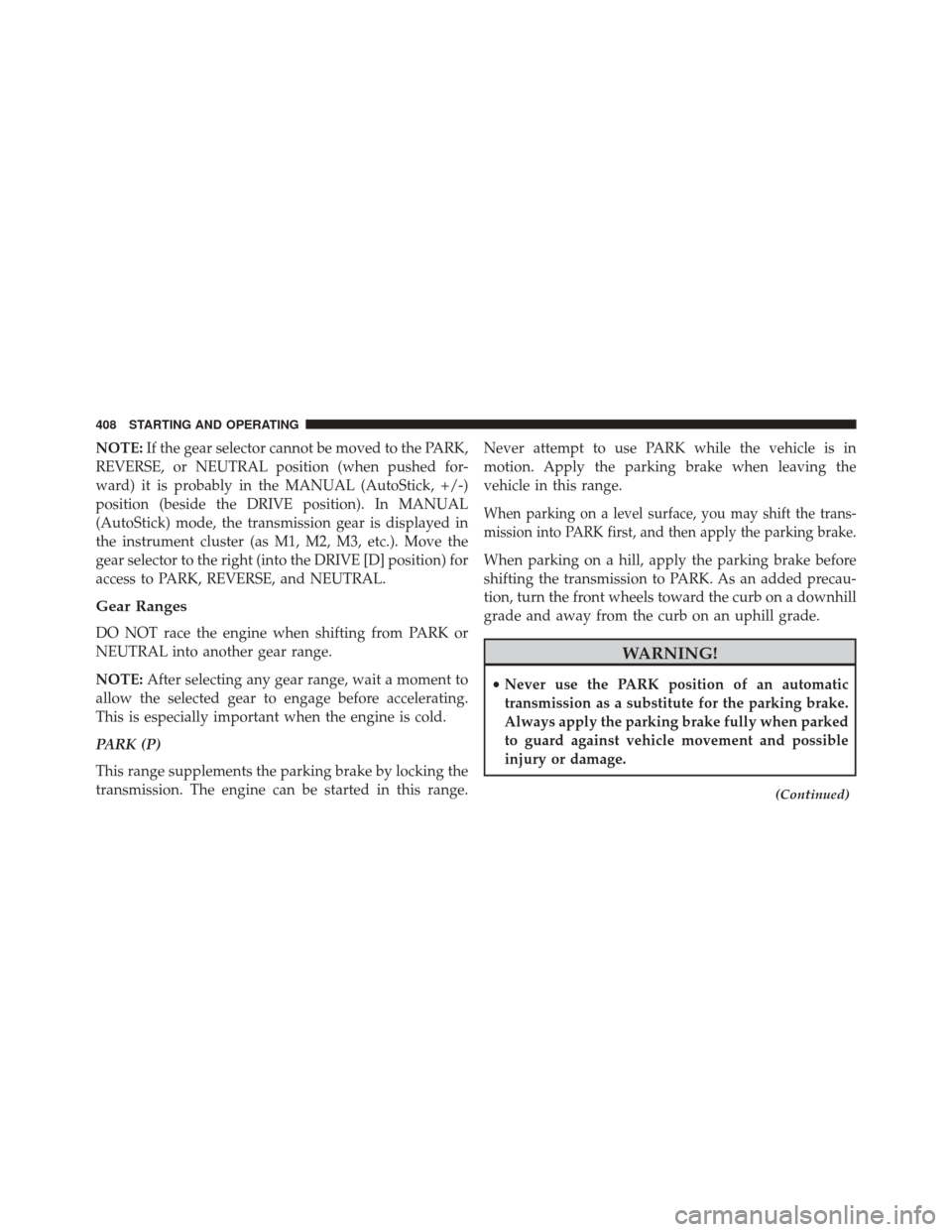
NOTE:If the gear selector cannot be moved to the PARK,
REVERSE, or NEUTRAL position (when pushed for-
ward) it is probably in the MANUAL (AutoStick, +/-)
position (beside the DRIVE position). In MANUAL
(AutoStick) mode, the transmission gear is displayed in
the instrument cluster (as M1, M2, M3, etc.). Move the
gear selector to the right (into the DRIVE [D] position) for
access to PARK, REVERSE, and NEUTRAL.
Gear Ranges
DO NOT race the engine when shifting from PARK or
NEUTRAL into another gear range.
NOTE: After selecting any gear range, wait a moment to
allow the selected gear to engage before accelerating.
This is especially important when the engine is cold.
PARK (P)
This range supplements the parking brake by locking the
transmission. The engine can be started in this range. Never attempt to use PARK while the vehicle is in
motion. Apply the parking brake when leaving the
vehicle in this range.
When parking on a level surface, you may shift the trans-
mission into PARK first, and then apply the parking brake.
When parking on a hill, apply the parking brake before
shifting the transmission to PARK. As an added precau-
tion, turn the front wheels toward the curb on a downhill
grade and away from the curb on an uphill grade.
WARNING!
•
Never use the PARK position of an automatic
transmission as a substitute for the parking brake.
Always apply the parking brake fully when parked
to guard against vehicle movement and possible
injury or damage.
(Continued)
408 STARTING AND OPERATING
Page 412 of 634
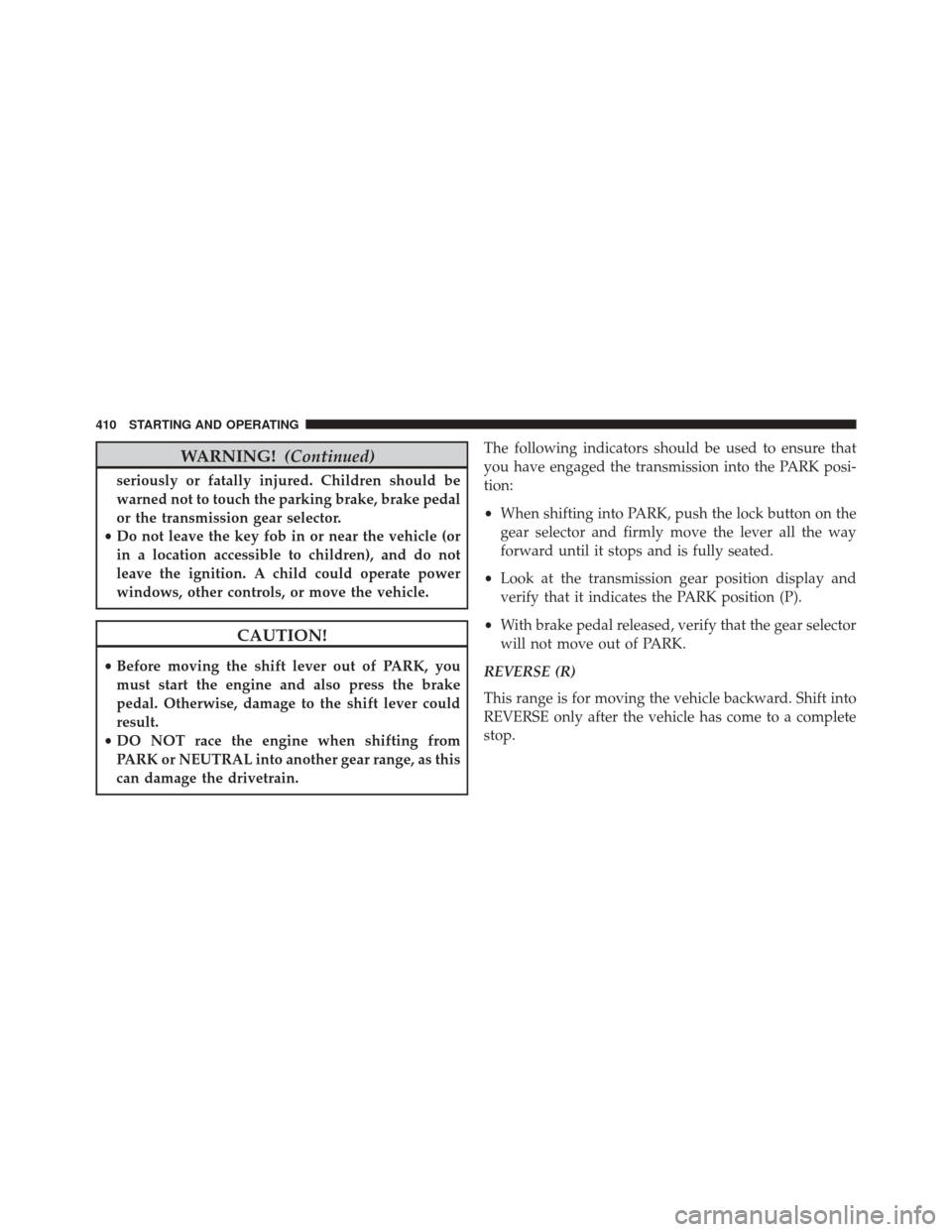
WARNING!(Continued)
seriously or fatally injured. Children should be
warned not to touch the parking brake, brake pedal
or the transmission gear selector.
• Do not leave the key fob in or near the vehicle (or
in a location accessible to children), and do not
leave the ignition. A child could operate power
windows, other controls, or move the vehicle.
CAUTION!
• Before moving the shift lever out of PARK, you
must start the engine and also press the brake
pedal. Otherwise, damage to the shift lever could
result.
• DO NOT race the engine when shifting from
PARK or NEUTRAL into another gear range, as this
can damage the drivetrain. The following indicators should be used to ensure that
you have engaged the transmission into the PARK posi-
tion:
•
When shifting into PARK, push the lock button on the
gear selector and firmly move the lever all the way
forward until it stops and is fully seated.
• Look at the transmission gear position display and
verify that it indicates the PARK position (P).
• With brake pedal released, verify that the gear selector
will not move out of PARK.
REVERSE (R)
This range is for moving the vehicle backward. Shift into
REVERSE only after the vehicle has come to a complete
stop.
410 STARTING AND OPERATING
Page 414 of 634
![DODGE CHARGER SRT 2016 7.G Owners Manual Under these conditions, using a lower gear will improve
performance and extend transmission life by reducing
excessive shifting and heat buildup.
During extremely cold temperatures (-22°F [-30°C] or DODGE CHARGER SRT 2016 7.G Owners Manual Under these conditions, using a lower gear will improve
performance and extend transmission life by reducing
excessive shifting and heat buildup.
During extremely cold temperatures (-22°F [-30°C] or](/manual-img/12/5584/w960_5584-413.png)
Under these conditions, using a lower gear will improve
performance and extend transmission life by reducing
excessive shifting and heat buildup.
During extremely cold temperatures (-22°F [-30°C] or
below), transmission operation may be modified depend-
ing on engine and transmission temperature as well as
vehicle speed. Normal operation will resume once the
transmission temperature has risen to a suitable level.
MANUAL (M)
The MANUAL (M, +/-) position (beside the DRIVE
position) enables full manual control of transmission
shifting (also known as AutoStick mode; refer to
“AutoStick” in this section for further information). Tog-
gling the gear selector forward (-) or rearward (+) while
in the MANUAL (AutoStick) position will manually
select the transmission gear, and will display the current
gear in the instrument cluster as M1, M2, M3, etc.Transmission Limp Home Mode
Transmission function is monitored electronically for
abnormal conditions. If a condition is detected that could
result in transmission damage, Transmission Limp Home
Mode is activated. In this mode, the transmission may
operate only in certain gears, or may not shift at all.
Vehicle performance may be severely degraded and the
engine may stall. In some situations, the transmission
may not re-engage if the engine is turned off and
restarted. The Malfunction Indicator Light (MIL) may be
illuminated. A message in the instrument cluster will
inform the driver of the more serious conditions, and
indicate what actions may be necessary.
In the event of a momentary problem, the transmission
can be reset to regain all forward gears by performing the
following steps.
412 STARTING AND OPERATING
Page 416 of 634
This system can also provide you with more control
during passing, city driving, cold slippery conditions,
mountain driving, and many other situations.Operation
When the gear selector is in the DRIVE (D) position, the
transmission will operate automatically, shifting between
the eight available gears. To activate AutoStick, move the
gear selector into the MANUAL (M) position (beside the
DRIVE position). The current transmission gear will be
displayed in the instrument cluster, along with a high-
lighted�M�(Manual) indication. When the gear selector
is in the MANUAL (M) position, tap the gear selector
forward (-) (or tap the (-) shift paddle on the steering
wheel) to downshift the transmission to the next lower
gear, (or tap the lever rearward (+) or tap the (+) shift
paddle), to command an upshift.
Paddle Shifters
1 — (–) Shift Paddle 2 — (+) Shift Paddle
414 STARTING AND OPERATING
Page 417 of 634
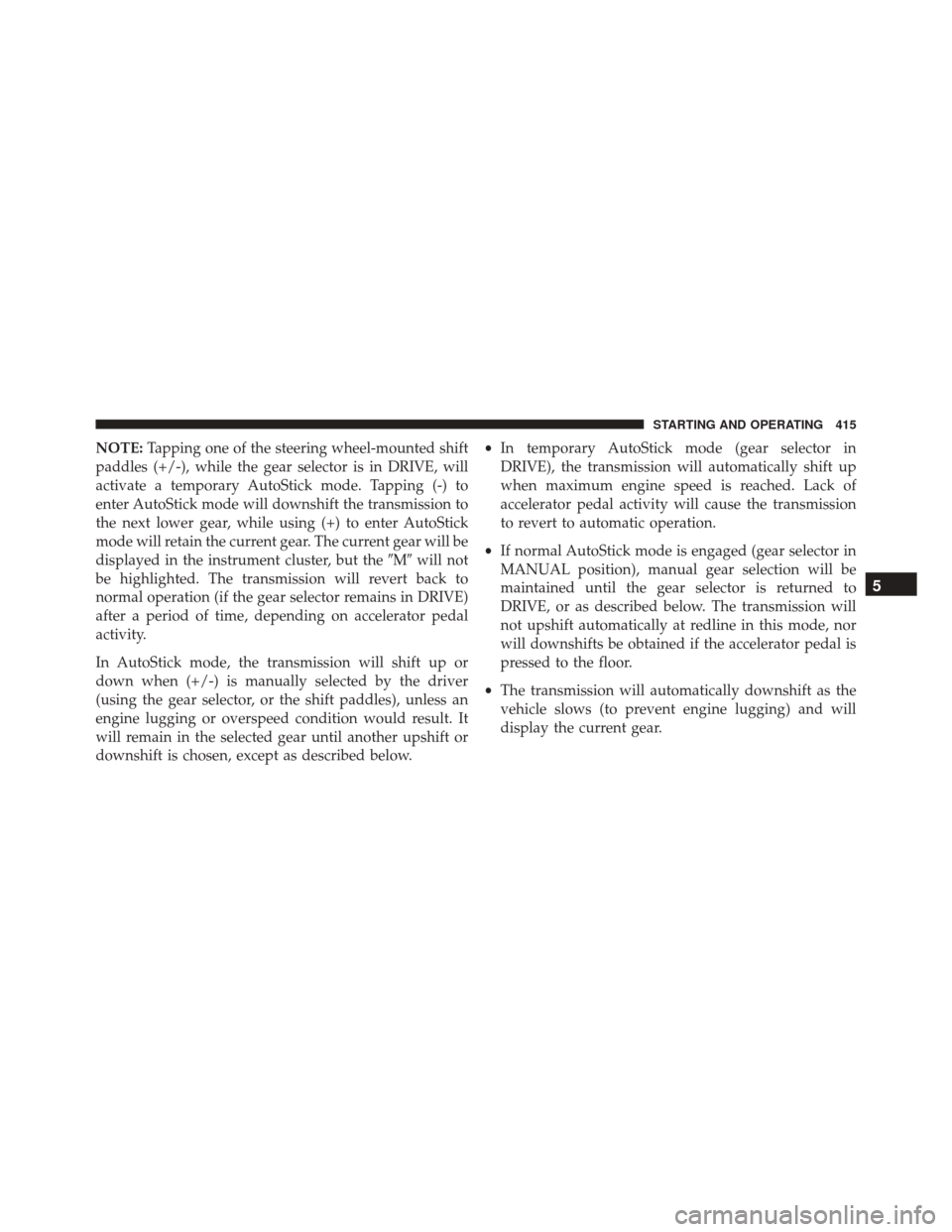
NOTE:Tapping one of the steering wheel-mounted shift
paddles (+/-), while the gear selector is in DRIVE, will
activate a temporary AutoStick mode. Tapping (-) to
enter AutoStick mode will downshift the transmission to
the next lower gear, while using (+) to enter AutoStick
mode will retain the current gear. The current gear will be
displayed in the instrument cluster, but the �M�will not
be highlighted. The transmission will revert back to
normal operation (if the gear selector remains in DRIVE)
after a period of time, depending on accelerator pedal
activity.
In AutoStick mode, the transmission will shift up or
down when (+/-) is manually selected by the driver
(using the gear selector, or the shift paddles), unless an
engine lugging or overspeed condition would result. It
will remain in the selected gear until another upshift or
downshift is chosen, except as described below. •
In temporary AutoStick mode (gear selector in
DRIVE), the transmission will automatically shift up
when maximum engine speed is reached. Lack of
accelerator pedal activity will cause the transmission
to revert to automatic operation.
• If normal AutoStick mode is engaged (gear selector in
MANUAL position), manual gear selection will be
maintained until the gear selector is returned to
DRIVE, or as described below. The transmission will
not upshift automatically at redline in this mode, nor
will downshifts be obtained if the accelerator pedal is
pressed to the floor.
• The transmission will automatically downshift as the
vehicle slows (to prevent engine lugging) and will
display the current gear.
5
STARTING AND OPERATING 415